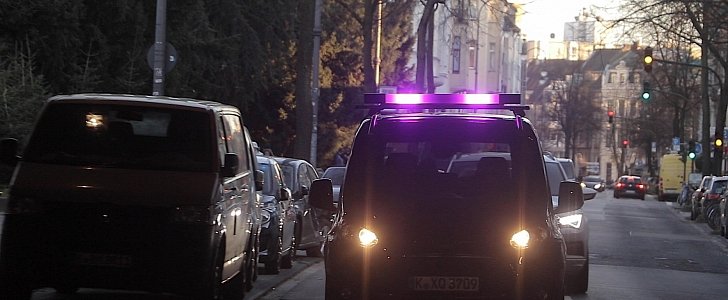After coming to terms with the fact that autonomous cars are going to become a reality, mostly thanks to companies unrelated to the industry, carmakers have joined a few years back the race to develop such vehicles. Today, all the big names are conducting research into AVs, with various degrees of success.
For the more advanced of the pack, like Ford or Mercedes, another challenge lies ahead: making people comfortable with self-driving cars, especially with the idea that a car with no driver that can yield.
Usually, pedestrians rely on eye contact with the driver to make sure the vehicle will stop and let them pass, but that’s an impossible thing to do when a computer is calling the shots.
So a system needs to be devised to allow AVs to display their intentions. And the easiest such system is one based on light signals.
This year, we’ve already learned of Jaguar Land Rover and Mercedes-Benz working on such technologies. The former relies on painting the road in front with light bars, while the latter on strips of turquoise lights fitted all over an S-Class.
Last week, Ford revealed its take on the matter, one that is close to the one used by Mercedes. By fitting the top of a Transit Connect van with a light bar, Ford tricked pedestrians into thinking they were facing a self-driving car that communicated its intentions.
You can see how that went in the video attached below.
“Fundamentally, people need to trust autonomous vehicles and developing one universal visual means of communication is a key to that,” said in a statement Thorsten Warwel, Ford Europe core lighting manager.
“Turning someone into a ‘Human Car Seat’ was one of those ideas when there was a bit of a pause and then the realization that this was absolutely the best and most effective way of finding out what we needed to know.”
Although the idea in itself is not bad, with no rules to govern these communication techniques teaching pedestrians to speak car might prove extremely difficult.
Imagine having to learn to interpret a set of light signals coming from a Mercedes, another coming from a Ford, another from a Cruise...
Usually, pedestrians rely on eye contact with the driver to make sure the vehicle will stop and let them pass, but that’s an impossible thing to do when a computer is calling the shots.
So a system needs to be devised to allow AVs to display their intentions. And the easiest such system is one based on light signals.
This year, we’ve already learned of Jaguar Land Rover and Mercedes-Benz working on such technologies. The former relies on painting the road in front with light bars, while the latter on strips of turquoise lights fitted all over an S-Class.
Last week, Ford revealed its take on the matter, one that is close to the one used by Mercedes. By fitting the top of a Transit Connect van with a light bar, Ford tricked pedestrians into thinking they were facing a self-driving car that communicated its intentions.
You can see how that went in the video attached below.
“Fundamentally, people need to trust autonomous vehicles and developing one universal visual means of communication is a key to that,” said in a statement Thorsten Warwel, Ford Europe core lighting manager.
“Turning someone into a ‘Human Car Seat’ was one of those ideas when there was a bit of a pause and then the realization that this was absolutely the best and most effective way of finding out what we needed to know.”
Although the idea in itself is not bad, with no rules to govern these communication techniques teaching pedestrians to speak car might prove extremely difficult.
Imagine having to learn to interpret a set of light signals coming from a Mercedes, another coming from a Ford, another from a Cruise...





